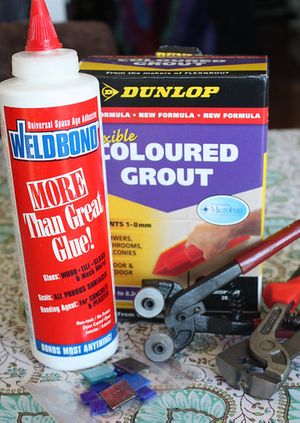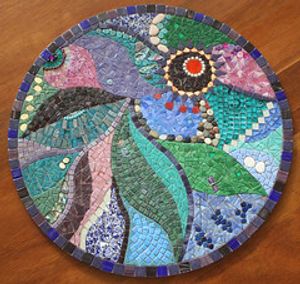mosaic beginnings
published onOver lunch with North Coast friend Margaret yesterday, I was asked for some advice on getting started on mosaic projects. I've never been one to follow 'rules' and apart from guidance from Wendy Tanner have pretty much learned what I know through experimentation and practice. So I'm probably not the best person to ask! However here's a few bits and pieces to get going. Wendy and others might like to add their bits and challenge my thinking :)
You need a few basics to get started. The wheel cutters are a little harder to find but some Bunnings hardware stores have them in the craft area OR find a mosaic supplier. WELDBOND is a good glue option although I've also successfully used Tarzans Grip (more toxic and expensive).

I prefer to work with thinner glass tiles for my projects but coloured wall tiles work well especially for larger/outdoor projects. Choose good quality tiles. I found some Turkish tiles chalky and that the glaze chipped off when cut. There are good mosaic suppliers on ETSY and EBAY. I shop regularly from Judysmosaics on Etsy who I can highly recommend. SOME tile outlets are generous and provide samples and discontinued lines free of charge but you'll need to search. But you can of course use all sorts of objects in your projects including:
- broken crockery
- stones
- shells
- old jewelry
- buttons
- beads
- mirror pieces
So start collecting! (Forget to tell you you'll end up needing a shed ;) )
While you need to start simple so you feel like you are getting somewhere, you also need to break away from the square tile approach and start breaking things! (I daren't tell the owners of plates at markets the destiny of their heirlooms LOL). I started with terracotta pots as a level final surface is not needed but you need a bit of perseverance with the gluing process as pieces slide - lie the pot on its side, prop to make it level and work vertically down the pot allowing each strip to dry a little before rotating. Tables and other products that require a flat surface are a little more challenging. My tables are not 100% flat but I do make the tiles the highest point with lower strips in between able to be straddled by a cup or glass. For larger vertical projects like walls, Wendy and others recommend gluing tiles onto mesh and then attaching the full sheet onto the wall surface with tile adhesive before grouting - see example. If you're using a timber base seal it before you begin by mixing some weldbond glue with water 50:50 and apply 2 coats. For outdoor products or those that will get wet use a waterproof base such as marine ply.
I personally hate 'paint by numbers' approaches to art but there are some gorgeous mandala and geometric type designs if you're not a confident designer. My designs either start with a doodly type of sketch and evolve, or in the case of pots are totally off the cuff. What I do take time to do is to think about colour. Gather together your tiles and ingredients and get a feel for themes and exclusions. But it's up to you!
The gluing process can be time consuming depending on the complexity of design and size of pieces. I estimate that my tables take the equivalent of around 40 hours to complete. The larger the gaps left between pieces, the more grout will be exposed - again its up to you and your preference. Before grouting allow the project to fully dry and then brush over or vacuum to remove loose pieces. Check for loose tiles that WILL cause grief during grouting. You'll get the hang of the amount of grout to mix over time. If you run out, keep the surface moist by covering with gladwrap while you mix more. If you are mixing colours mix more powder than needed and keep left-overs for future projects. Add water and mix to a paste that spreads easily - if too runny it'll run off the project, too dry and it won't slip easily between your tiles and will dry too quickly. Normal people would use rubber gloves for grouting but I prefer to feel the project and its shape as I work. It's messy so be prepared with bucket, newspaper, towels etc. A sponge and rubber squeegee for flat surfaces are handy. Wipe/scrape off as much excess grout as you can checking for gaps and then sponge your project as its drying until clean. Keep a small amount of grout wet for gaps that you've missed.
And that's pretty much it! I gather good sites and suppliers in a Diigo list which might be useful.
